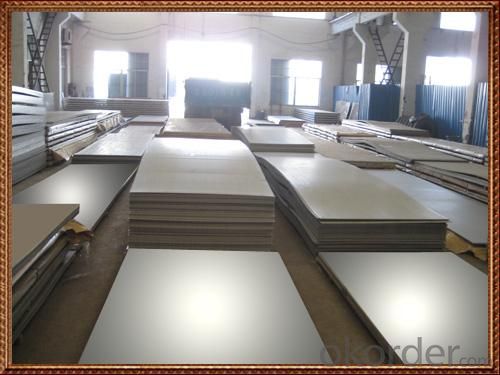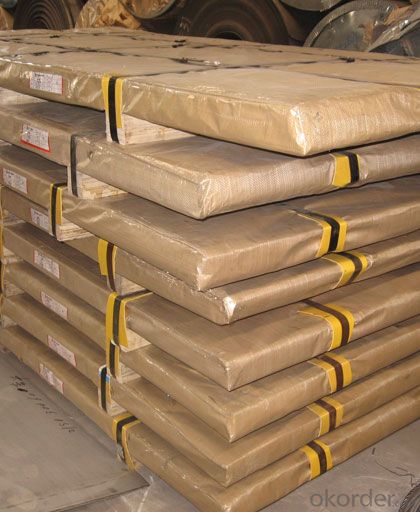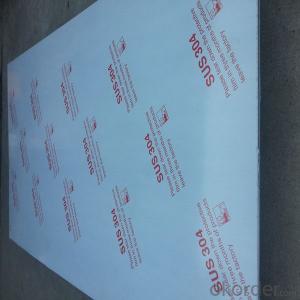304 Stainless Steel Sheet Brushed Surface with High Quality
- Loading Port:
- Shanghai
- Payment Terms:
- TT OR LC
- Min Order Qty:
- 3 m.t.
- Supply Capability:
- 40000 m.t./month
OKorder Service Pledge
OKorder Financial Service
You Might Also Like
Item specifice
304 stainless steel sheet brushed surface with high quality.
Product Description
Specification of 304 stainless steel sheet brushed surface
1. Material: 300series
2. Standard: JIS, AISI, ASTM, GB, DIN, EN
3. Thickness: 0.3-100mm or as customer’s requirement
4. Width: 1500-2200mm or as customer’s requirement
5. Length: 1000-6000mm or as customer’s requirement
6. Surface: 2B, BA, No.1, etc
7. Technical processing: Hot Rolled/Cold Rolled
8. Decoration:
Mirror, No.4, HL NSP, Bead Blast, Vibration,
HL Gold, Mirror Gold, Vibration Gold NSP,
No4 Copper NSP, Mirror Copper, Bead Copper,
HL Brass, Mirror Brass, Bead Brass,
HL Black, Mirror Black, Bead Black NSP,
HL Bronz, Mirror Bronze, Vibration Bronze,
Mirror Etched, HL Etched Copper, Mirror Black Etched, Mirror Etched Gold.
Surface finish of 304 stainless steel sheet brushed surface
2B,BA,HL,SB,BK,NO.1,NO.2,NO.4,NO.8,Polish,PVC,Brush,Mirror,Pickled,Annealed etc.

Mechanical property of 304 stainless steel sheet brushed surface
| Tensile Strength | σb (MPa)≥520 |
| Offset Yield Strength | σ0.2 (MPa)≥205 |
| Elongation | δ5 (%)≥40 |
| Reduction of Area | ψ (%)≥60 |
| Hardness | ≤187HB;≤90HRB;≤200HV |
| Density(20℃,g/cm3) | 7.93 |
| Melting Point(℃) | 1398~1454 |
| Specific Heat Capacity(0~100℃,KJ·kg-1K-1) | 0.5 |
| Thermal Conductivity(W·m-1·K-1) | (100℃)16.3,(500℃)21.5 |
| Coefficient of Linear Expansion(10-6·K-1) | (0~100℃)17.2,(0~500℃)18.4 |
| Electrical Resistivity(20℃,10-6Ω·m) | 0.73 |
| Longitudinal Modulus of Elasticity(20℃,KN/mm2) | 193 |
Chemical composition of 304 stainless steel sheet brushed surface
| 304 | C | Mn | P | S | Si | Cr | Ni |
| % | ≤0.08 | ≤2.00 | ≤0.045 | ≤0.030 | ≤1.00 | 17.5–20.0 | 8.0-11 |
Maintenance of 304 stainless steel sheet brushed surface
(1) Regular cleaning and maintenance
(2) Pay attention to prevent the occurrence of the phenomenon of surface scratches
(3) Use soap, weak detergent or warm water to remove surface dust, dirt
(4) In addition to the surface of the binder with alcohol or an organic solvent (ether, benzene)
(5) Use neutral detergent or ammonia solution in addition to surface oil
(6) With 10% nitric acid or abrasive detergent in addition to the surface of the embroider caused by the dirt.
Packaging & Shipping
Packaging way of stainless steel: Original packaging according to your needs. Standard export sea-worthy wooden packing.

Our Services
1.All product are made of high-quality stainless steel sheet;
2.We have good service & short delivery time;
3.We have professional export team;
4.We can provide sample for your evaluation;
5.We can provide Mill test certificate;
6.Your enquiry will get quickly and efficient response.
Why do you choose us?
1)Our products are high quality and best price.
2)We have experience in this line for many years.
3)We have professional team and the factory.
4)It's very important for a company to be honest in the process of trading and so do we.
5)Our products are exported to countries around the world.
- Q:Are stainless steel sheets resistant to intergranular corrosion?
- Yes, stainless steel sheets are generally resistant to intergranular corrosion. This is because stainless steel contains a high percentage of chromium, which forms a protective oxide layer on the surface of the metal. This oxide layer acts as a barrier, preventing the metal from coming into contact with corrosive elements in the environment. However, in certain conditions, such as exposure to high temperatures or welding processes, the chromium in stainless steel can be depleted, leading to the formation of chromium carbides at the grain boundaries. This can result in intergranular corrosion, also known as sensitization. To mitigate this, stainless steel sheets can be treated through a process called stabilization, which involves adding elements like titanium or niobium to the steel to bind with the carbon and prevent the formation of chromium carbides. Overall, stainless steel sheets are highly resistant to intergranular corrosion, but precautions should be taken in specific situations to maintain their corrosion-resistant properties.
- Q:Can stainless steel sheets be used for decorative ceiling tiles?
- Indeed, decorative ceiling tiles can be created using stainless steel sheets. Renowned for its durability, resistance to corrosion, and aesthetic allure, stainless steel is a versatile material. It can be effortlessly tailored and fashioned into an assortment of designs, textures, and finishes, rendering it an exceptional option for decorative applications. By incorporating stainless steel ceiling tiles, any environment, be it residential, commercial, or industrial, can acquire a contemporary and polished appearance. Furthermore, stainless steel proves to be a practical choice in areas where cleanliness is of utmost importance, as it is facile to clean and maintain.
- Q:How do stainless steel sheets differ from regular steel sheets?
- Stainless steel sheets differ from regular steel sheets primarily in terms of their composition and properties. While regular steel sheets are made of iron and carbon, stainless steel sheets contain additional alloys such as chromium, nickel, and manganese. This composition gives stainless steel sheets a higher resistance to corrosion, making them more durable and suitable for applications where exposure to moisture or harsh environments is a concern. Additionally, stainless steel sheets have a distinctive shiny appearance, known as the stainless steel "finish," which can be maintained even with frequent use.
- Q:What are the common applications for stainless steel sheets?
- Due to their exceptional properties and durability, stainless steel sheets find a wide range of applications. They are utilized in various industries for different purposes. Some of the common uses include: 1. Architectural purposes: Stainless steel sheets are commonly employed in architectural projects like cladding, roofing, and wall panels. They not only provide a sleek and modern appearance to buildings but also offer corrosion resistance and easy maintenance. 2. Kitchenware manufacturing: Stainless steel sheets are widely used in the production of kitchen appliances, sinks, countertops, and cookware. Their resistance to stains, heat, and corrosion makes them ideal for use in kitchens. 3. Automotive industry: Stainless steel sheets are extensively utilized in the automotive sector for manufacturing exhaust systems, body parts, and trim. They provide strength, corrosion resistance, and an attractive finish, making them suitable for both functional and aesthetic purposes. 4. Medical equipment production: Stainless steel sheets are commonly employed in the manufacturing of medical equipment and instruments. This is due to their hygienic properties, resistance to corrosion, and staining. They are used in surgical instruments, dental tools, hospital equipment, and implants. 5. Chemical and petrochemical industries: The chemical and petrochemical industries extensively use stainless steel sheets due to their resistance to high temperatures, chemicals, and corrosion. They are employed in storage tanks, pipelines, heat exchangers, and other equipment that comes into contact with corrosive substances. 6. Food processing industry: Stainless steel sheets are highly sought after in the food processing industry because of their hygienic properties and resistance to corrosion. They are used to create food preparation surfaces, storage containers, and machinery that must meet strict sanitary standards. 7. Construction projects: Stainless steel sheets are used in construction projects such as bridges, tunnels, and railway tracks due to their strength, durability, and resistance to corrosion. They are also utilized in the construction of industrial buildings, warehouses, and infrastructure. 8. Aerospace industry: Stainless steel sheets find applications in the aerospace industry for various components, including aircraft frames, engine parts, and interior fittings. They offer an excellent strength-to-weight ratio, corrosion resistance, and heat resistance, making them suitable for demanding aerospace applications. In conclusion, stainless steel sheets are a versatile and widely used material in various industries due to their exceptional properties. They are indispensable for many applications.
- Q:Are stainless steel sheets suitable for food preparation surfaces?
- Stainless steel sheets are highly suitable for food preparation surfaces, making them a top pick for kitchen countertops, cutting boards, and other areas where food is prepared. The many advantageous properties of stainless steel contribute to its popularity. Firstly, it is non-porous, meaning it does not absorb smells, flavors, or bacteria. This characteristic ensures high levels of hygiene and easy cleaning, reducing the risk of cross-contamination. Additionally, stainless steel is resistant to corrosion, staining, and heat, making it a long-lasting and durable option. Its smooth surface is also perfect for rolling out dough or chopping ingredients. Moreover, stainless steel is non-reactive, so it does not interact with acidic or alkaline foods, preserving the taste and quality of the prepared dishes. All in all, stainless steel sheets are an exceptional choice for food preparation surfaces due to their cleanliness, durability, and food safety qualities.
- Q:Can stainless steel sheets be used for water tanks or storage containers?
- Certainly, water tanks or storage containers can be made using stainless steel sheets. This material is widely chosen for these purposes because of its remarkable resistance to corrosion and durability. Its ability to resist rust and corrosion makes it perfect for storing water or other liquids. Moreover, stainless steel is hygienic and effortless to clean, which is vital for preserving the purity of stored water or food items. Furthermore, stainless steel sheets can be easily shaped and sized to meet the specific needs of the water tank or storage container. All in all, stainless steel sheets are a dependable and enduring choice for water tanks or storage containers.
- Q:Can stainless steel sheets be used for elevator shafts?
- Yes, stainless steel sheets can be used for elevator shafts. Stainless steel is a popular choice for elevator shafts due to its durability, corrosion resistance, and aesthetic appeal. The use of stainless steel sheets for elevator shafts ensures a long-lasting and low-maintenance solution, as they are resistant to rust and corrosion caused by factors such as humidity, moisture, and chemicals. Additionally, stainless steel is strong and can withstand the weight and stress that elevator shafts may experience. The sleek and modern appearance of stainless steel also adds value to the overall design of the elevator shaft. Therefore, stainless steel sheets are a suitable and reliable material for constructing elevator shafts.
- Q:What are the different types of edge finishes available for stainless steel sheets?
- There are several different types of edge finishes available for stainless steel sheets. These finishes are applied to the edges of the sheets to provide a clean and polished appearance, as well as to protect against sharp edges and potential corrosion. 1. Mill Finish: This is the standard edge finish for stainless steel sheets. It is the raw, untreated edge that is produced during the manufacturing process. While it may have a slightly rough or uneven appearance, it is still functional and commonly used for industrial applications. 2. Deburred Edges: In order to remove any sharp or jagged edges, the stainless steel sheet can be deburred. This is done by grinding or sanding down the edges to create a smoother and safer finish. Deburred edges are commonly used in applications where safety is a concern, such as in food processing or medical equipment. 3. Rounded Edges: Rounded edges are created by using a rounding tool to smooth out the sharp corners of the stainless steel sheet. This type of edge finish not only enhances the aesthetics of the sheet, but also reduces the risk of injury from sharp edges. Rounded edges are often preferred for architectural or decorative applications. 4. Beveled Edges: Beveled edges are achieved by cutting or grinding the edge of the stainless steel sheet at a specific angle, typically 45 degrees. This creates a chamfered edge that adds a sleek and modern look to the sheet. Beveled edges are commonly used in applications where aesthetics and design are important, such as in furniture or interior design. 5. Polished Edges: Polished edges involve buffing or polishing the edge of the stainless steel sheet to create a smooth and mirror-like finish. This type of edge finish adds a touch of elegance and sophistication to the sheet, making it suitable for high-end architectural or decorative applications. In summary, the different types of edge finishes available for stainless steel sheets include mill finish, deburred edges, rounded edges, beveled edges, and polished edges. Each finish offers its own unique benefits and is chosen based on the specific requirements of the application.
- Q:Can stainless steel sheets be polished?
- Stainless steel sheets, indeed, possess the ability to undergo polishing. The act of polishing these sheets serves the purpose of enhancing their visual appeal, resulting in the creation of a sleek and lustrous surface. This procedure typically entails the utilization of abrasive substances like sandpaper, polishing compounds, or specialized machinery in order to eliminate any flaws or marks present on the stainless steel sheet's surface. This task can be accomplished both manually or with the assistance of specific equipment. By polishing stainless steel sheets, not only does their aesthetic allure become enhanced, but their susceptibility to corrosion and staining is also significantly reduced.
- Q:How do you prevent galvanic corrosion on stainless steel sheets?
- To prevent galvanic corrosion on stainless steel sheets, there are several measures that can be taken: 1. Use compatible materials: Ensure that any other metals or materials in contact with the stainless steel sheets are also corrosion-resistant. Avoid coupling stainless steel with dissimilar metals, especially those with a higher electrochemical potential difference, as this can accelerate galvanic corrosion. 2. Insulate and isolate: Create a physical barrier or insulating layer between the stainless steel sheets and any dissimilar metals. This can be achieved through the use of gaskets, seals, or non-conductive coatings. By preventing direct contact between the stainless steel and other metals, the risk of galvanic corrosion is reduced. 3. Proper installation: During installation, ensure that stainless steel sheets are properly grounded and separated from other metals. This helps to minimize the potential for galvanic corrosion by reducing the flow of electrical currents between dissimilar metals. 4. Regular maintenance: Regularly inspect and clean stainless steel sheets to remove any contaminants or foreign materials that could contribute to galvanic corrosion. This includes removing any rust, scale, or deposits that may have formed on the surface. 5. Cathodic protection: Consider implementing a cathodic protection system, such as sacrificial anodes or impressed current systems, to provide an additional layer of protection against galvanic corrosion. These systems work by introducing a sacrificial metal that corrodes in place of the stainless steel, effectively preventing corrosion of the stainless steel sheets. By taking these preventative measures, it is possible to significantly reduce the risk of galvanic corrosion on stainless steel sheets and extend their lifespan.
1. Manufacturer Overview |
|
|---|---|
| Location | |
| Year Established | |
| Annual Output Value | |
| Main Markets | |
| Company Certifications | |
2. Manufacturer Certificates |
|
|---|---|
| a) Certification Name | |
| Range | |
| Reference | |
| Validity Period | |
3. Manufacturer Capability |
|
|---|---|
| a)Trade Capacity | |
| Nearest Port | |
| Export Percentage | |
| No.of Employees in Trade Department | |
| Language Spoken: | |
| b)Factory Information | |
| Factory Size: | |
| No. of Production Lines | |
| Contract Manufacturing | |
| Product Price Range | |
Send your message to us
304 Stainless Steel Sheet Brushed Surface with High Quality
- Loading Port:
- Shanghai
- Payment Terms:
- TT OR LC
- Min Order Qty:
- 3 m.t.
- Supply Capability:
- 40000 m.t./month
OKorder Service Pledge
OKorder Financial Service
Similar products
New products
Hot products
Related keywords





























